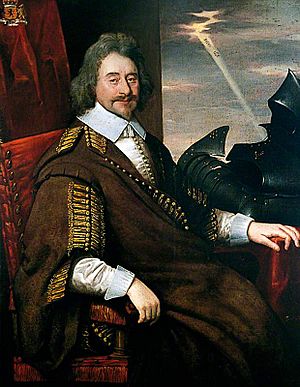Ferdinando Fairfax, 2nd Lord Fairfax of Cameron facts for kids
Ferdinando Fairfax, 2nd Lord Fairfax of Cameron (born March 29, 1584 – died March 14, 1648) was an English nobleman and politician. He served in the House of Commons, which is like a part of the government, at different times from 1614 to 1648. He was also an important leader in the Parliamentary army during the English Civil War. It's good to know he was the father of Thomas Fairfax, who became even more famous for leading the New Model Army.
Contents
Early Life and Education
Ferdinando Fairfax was born in Yorkshire. He was the oldest son of Ellen Aske and Thomas Fairfax, 1st Lord Fairfax of Cameron. In 1627, King Charles I made his father a "Lord Fairfax of Cameron" in the Peerage of Scotland. This meant his father became a Scottish noble.
Ferdinando received military training in the Netherlands. He had several brothers. Two of them were Henry Fairfax and Charles Fairfax. Sadly, four of his other brothers died while serving in the military overseas.
Political Career
Ferdinando Fairfax was a member of the English parliament. He represented the area of Boroughbridge in six different parliaments between 1614 and 1629. He also served in the "Short Parliament" in 1640.
In May 1640, he became the Lord Fairfax after his father passed away. Even though he was a Scottish noble, he still sat in the English House of Commons. He represented Yorkshire in the "Long Parliament" from 1640 until he died.
Fairfax supported the Parliament, but he was a moderate person. This means he preferred peaceful solutions and wanted to avoid conflict. His main home was Denton Hall in Wharfedale, Yorkshire.
Military Service and Leadership
Early Conflicts
Before the English Civil War began, Fairfax led a group of soldiers in the king's army during the first Bishops' War. When the English Civil War started in 1642, he became the leader of the Parliament's forces in Yorkshire. His main opponent was Newcastle, who led the Royalist army.
The fighting began after a peace agreement, called a treaty of neutrality, was broken. At first, Fairfax didn't have much success. He was forced to retreat from York to Selby, and then to Leeds in 1643.
Key Battles and Victories
After defending Leeds from an attack, he faced a major defeat on June 30, 1643, at the Battle of Adwalton Moor. He managed to escape to Hull. He successfully defended Hull against Newcastle's siege from September 2 to October 11, 1643. He even led a clever attack that made the Royalists give up their siege.
Fairfax won a battle at Selby on April 11, 1644. He then joined forces with the Scottish army and helped besiege York. He was also present at the famous Battle of Marston Moor on July 2, 1644. During this battle, he commanded the infantry, but his forces were defeated.
Governor of York
After Marston Moor, in July 1644, Fairfax was made the Governor of York. His job was to bring the rest of the county under Parliament's control. In December 1644, he captured the town of Pontefract, but he couldn't take the castle.
Writings and Reports
While he was in command in Yorkshire, Fairfax also wrote some important documents. He wrote The Answer of Ferdinando, Lord Fairfax, to a Declaration of William, Earl of Newcastle in 1642. He also published A Letter from . . . Lord Fairfax to . . . Robert, Earl of Essex in 1643. This letter described his successful attack during the siege of Hull.
Later Life and Family
Fairfax gave up his military command when the "Self-denying Ordinance" was passed. This was a rule that said members of Parliament could not also be military commanders. However, he remained part of the Committee for the Government of Yorkshire. On July 24, 1645, he was appointed the manager of the Pontefract estate.
Ferdinando Fairfax died on March 14, 1648, due to an accident that caused an infection in his foot. He was buried at All Saints' Church, Bolton Percy in Yorkshire.
Marriages and Children
Fairfax was married twice. With his first wife, Mary Sheffield, he had six daughters and two sons. His son Thomas Fairfax became the third Lord Fairfax after him. His other son, Charles, was a colonel in the army and died at the Battle of Marston Moor.
His second wife was Rhoda Chapman, whom he married in October 1646. They had one daughter named Ursula.



